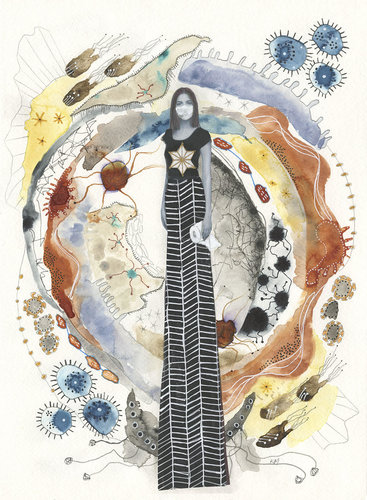by CarolynEdlund
The Coronavirus pandemic has led to a cascade of event cancellations and the loss of opportunities for many artists. Authorities are recommending self-isolation to stem the spread of the virus. What do we do now?

“Going Viral” by Alan Richards, image composite, size varies
Besides posing personal health risks, the outbreak may have turned your entire business upside down. During the recommended self-isolation period, take time to consider your options and rethink strategies. Here are 50 ways that artists in business can use this downtime constructively:
Get into the Studio
- Make art (your most important job!)
- Clean and organize your studio.
- Prepare materials and supplies to be used during the artmaking process. Take steps like mixing glazes, gessoing canvases, or sorting collage materials.
- Rethink your space to set up a more efficient workflow. Or, rearrange your studio to create a display area for studio visits and sales.
- Inventory artwork that is on hand and make record of everything that is out of your studio for any reason. Artwork Archive is a good online tool for this use.
- Check your stock of materials and supplies. List what you need, and place orders. If you want to buy in bulk, you may want to connect online with other artists who are willing to go in on a volume order with you.
- Do you work in a group studio setting? Meet virtually to discuss how to continue to market and promote all artists despite a building closure, and ways to be supportive of artists who are ill.
- Place a guest book in your space to gather names, email addresses and other contact information of studio visitors.
Manage Existing Business and Make New Sales
- Review contracts and commitments that have been cancelled or suspended, then contact your clients to discuss. Can projects be postponed rather than lost? Can events be formatted differently, such as teaching or speaking online rather than in person?
- Reach out to your collector base personally to wish them well and renew relationships via email, social media or even a phone call. They are a huge asset to your business and one of the best sources of future sales.
- In person sales may have slowed, but online sales can go full speed ahead if you make them a priority. Get started with our directory of places to sell art online to locate those that are a good match for you.
- Evaluate all third-party sites that currently sell your art. Are they working well for you? If not, update your profile and add new images and content to give your best presentation. Or, choose to let that outlet go, and close your account. Don’t leave out-of-date pages online.
- Use social media as a marketplace by selling directly on those sites. Tools such as Soldsie or CommentSold can help turn your social posts into a shopping cart.
- Send email campaigns to your list offering a limited-time sale, and an opportunity to own a piece of your work.
Create or Update Collateral
- Evaluate your portfolio. Is it up to date, reflecting your most current work and the direction you are going? Is it too big or too small? Self-curate and remove work that is not your best, is inconsistent with your other work or reflects something you no longer make.
- Organize your portfolio images into collections. This can make it easier to view and more understandable to collectors. It can also be useful when you want to access works in a specific theme or medium for presentation.
- Review your artist statement. Are you satisfied with it? Fine tune your statement and turn it into a stellar supporting document for your portfolio.
- Review your CV to make sure it is current and accurate.
- Take photos of your work. These could be jury photos, work in progress, detail shots to share on social media, on your blog or for the press.
Improve Your Art Website
- Do a self-critique of your artist website and get input from others, too. Does it provide an excellent visitor experience? Does it need revising, or a complete redo?
- Work on your SEO. Add keywords and image tags that help your site appear in more online searches.
- Check all links on your site to make sure they are working and repair or remove broken ones. Make sure outbound links open in a new browser window.
- Become acquainted with Google Analytics. Evaluate website traffic sources, pages viewed, and visitor demographics to better understand how your site is functioning and how to improve.

“Pandemic” by Kate Morgan, mixed media collage on watercolor paper
Look at the Big Picture
- Review your business objective and make adjustments. What do you want to achieve in the next year, five years, ten years? Get clear on what your ideal business would look like.
- Take a look at your long-term and short-term goals. Plan how you will measure progress and results.
- What structures do you have in place to grow your business? Have you created systems to consistently market, develop prospects, and close sales? If not, what are you missing? Make a list of what you need.
Increase Your Business IQ
- Lots of business learning takes place online, and this is the perfect time to take advantage of these resources. Start reading business articles here.
- Enroll in a solid art business learning program, such as the CHF digital campus, which starts at a free level.
- Connect with other artists you know to form business discussion groups and invite members to share their experience and expertise. Meet online using tools like Zoom that can be used free of charge.
Get Your Finances in Order
- Do your taxes.
- Review your income from last year. Where did the majority of it come from? What are you doing this year to build on that stream or develop new ones?
- Plan a budget.
- Check the prices you are charging for your work. Is it time for an increase? Are you leaving money on the table?
Plan Marketing and Publicity
- Craft social media posts that share your story with your audience. An authentic approach that others can relate to is best.
- Sign up for a social media management tool that allows you to pre-schedule content for your followers. Buffer and HootSuite are examples of these.
- Engage an email service provider, build a template and plan your first campaign. I use and recommend Constant Contact for their outstanding customer service.
- Create a video and post on YouTube to share your artwork, talk about your technique, or offer educational content. YouTube is a powerful search engine that can increase your website traffic.
- Create a press release for an upcoming exhibition, event or new release – leaving space to revise dates and details.
- Do you publish a blog? Take time to catch up with a new article, and brainstorm blog ideas for future posts.
- Plan a marketing calendar, scheduling regular outreach through different channels, including email, social media, direct mail, advertising, etc. Keep your work and your story in front of others using drip marketing techniques.
- Put together a media kit. This can be a terrific tool to present your work professionally in one cohesive package.
- Do you have a compelling story that is press-worthy? Reach out to press members for an interview or other coverage, and generate publicity for your work.
Grow Your Network
- Establish or update your LinkedIn profile, and start making connections with other people who could be valuable to know. Join groups on the site for industry discussion.
- Join a Facebook discussion group; many specialty groups exist that are particularly valuable for artists. They offer answers, resources and feedback from others in the business.
Be Good to Yourself and Others
- Dive into that stack of art magazines and catch up on your reading.
- Read an inspirational book about the business of art.
- Consider supporting a good cause by donating a piece of art or auctioning your work and giving a percentage of the proceeds to charity. You may want to support a cause that relates strongly to the concept and theme of your art.
- Actively participate in online discussions and social media with artists and friends to keep up morale, share news and encouragement.
- Relax, meditate, eat well and focus on a healthy body and mindset.
- Practice good hygiene. Take care of yourself and your loved ones. Be well!
Artist credit: Alan Richards and Kate Morgan


Thank you, Carolyn. There’s so much we can use this newfound time for, as you’ve so well illustrated here. I’ve been doing a few of the things you mentioned, but you’ve brought up others I’d forgotten about (like working on SEO keywords) or that just tend to fall through the cracks in normal life. In addition to the public health fears that loom at this time, many of us are taking a financial hit. Using this time to fine tune our business operations and systems could give us a step up in getting back on track. It also allows us to practice focusing mental energy on things other than the news. Thanks for a motivating list!
Paula, you are so right that we need to focus our mental energy on positive things rather than watching the news – which is exhausting! Being able to take action and affect things in a constructive direction gives us a bit of control when things seem overwhelming.
I love this! As an ADDish person with a currently open schedule, having a list like this is really useful to help me focus. Thanks, Carolyn!
Thanks, Julia. I hope you are able to get some things accomplished, make some art and stay healthy!
Thank you for writing this extremely helpful and detailed article. I even posted it on Facebook so your ideas can be read by more people. I do know that a show of my work scheduled for June will more than likely not happen. Using your suggestions, I will find a way to put the show online in some kind of different format. May we be safe, remain healthy, and be creative during this challenging time.
Good thinking, Mary Lou. That June show may turn into a future opportunity as venues scramble to plan and compensate for lost business and exhibitions. Or, have a virtual show as you mentioned. The place to be is online – which is 100% virus-free place to connect (except for computer viruses I suppose!)
I am making notes on lessons learned from CV 19. I use pen and paper.
I have rolodex addresses, an I am sending HANDWRITTEN mail to my art team members.
Direct mail works non stop. I use it all the time.
Hi Bob, great idea to use direct mail. In these days of filled inboxes and mailboxes with nothing but ads, a handwritten piece of mail really stands out.
Nice and helpful list/ article!